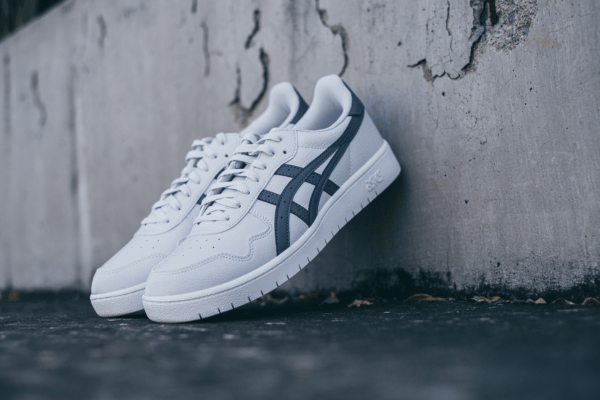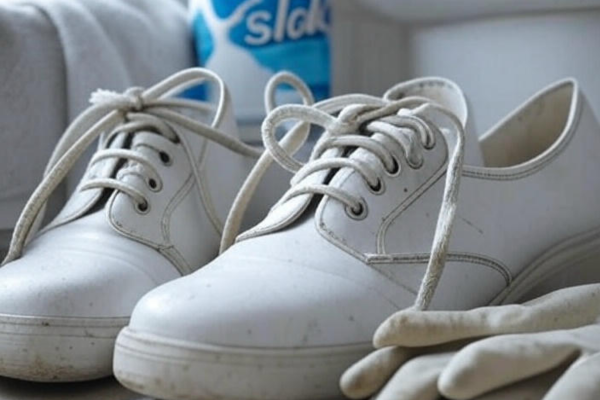1: Introduction
Shoelaces may seem small, but they have a big impact on your shoe’s comfort, fit, and performance. Whether you’re heading to the gym, the office, or a hiking trail, the type of shoelace you choose matters more than you think. In the debate of flat vs round shoelaces, each style offers unique benefits. Flat laces provide a comfortable fit and are often seen in sneakers and sports shoes, while round laces are typically more durable and better suited for hiking boots or outdoor use. Knowing the difference between these shoelace types can help you choose the best option for daily wear, athletic performance, or rugged terrain. The right shoelaces not only boost your shoe’s performance but also enhance its overall appearance and style.
2: Round or Flat Laces – Which Is Better?
When it comes to flat vs round shoelaces, many people ask the same question: which one is better? Your ideal choice comes down to the kind of shoes you wear, how active you are, and what feels right for you.
Let’s break it down with a quick comparison:
Quick Comparison Table
FeatureFlat LacesRound LacesStyle Sporty, modern Classic, rugged GripStronger hold, less likely to untie Can loosen if not double-knottedComfort Even pressure across footMay cause pressure points on top Best ForSneakers, running shoes, daily wear Hiking boots, work boots, dress shoes
Quick Comparison: Flat vs Round Shoelaces
| Feature | Flat Laces | Round Laces |
|---|---|---|
| Style | Sporty, modern look | Classic, rugged appearance |
| Grip | Strong hold, stays tied easily | Can loosen if not double-knotted |
| Comfort | Distributes pressure evenly across the foot | May cause pressure points on the top of the foot |
| Best For | Sneakers, running shoes, daily wear | Hiking boots, work boots, formal shoes |
Visual Difference and Feel
- Flat laces are wider and lay flat on the shoe. They look clean and stay in place better during high movement activities.
- Round laces have a denser build, are usually thicker in design, and resemble the texture of a small rope. They may roll or slip if not tied tightly.
The feel also differs:
- Flat laces offer a snug and stable fit, great for sports or all-day use.
- Round shoelaces offer extra strength and durability, making them a common choice for hiking footwear and dress shoes.
User Preferences Based on Shoe Type
Flat Laces
Popular in:
- Sneakers
- Running shoes
- Daily wear trainers
Reason: They stay tight, don’t untie easily, and look more casual.
Round Laces
Common in:
- Hiking boots
- Dress shoes
- Work boots
Reason: Stronger construction, matches the rugged or formal look.
Final Note:
So, which is better? If your focus is style and comfort for daily wear, go for flat laces. If you need strength and durability, especially for boots, round laces are the better choice.
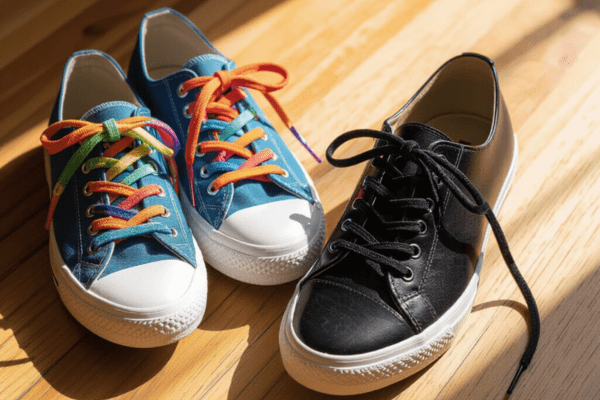
3: Which Shoelace Type Is Stronger – Flat or Round?
When it comes to strength and durability, the choice between flat vs round shoelaces depends on how they’re made and what they’re made of. Let’s break it down:
1. Material Difference
Flat and round shoelaces can be made from cotton, polyester, nylon, or even Kevlar. But the construction style affects strength too:
- Round shoelaces are usually tightly woven or braided, which adds extra tension support.
- Flat laces are often looser in weave, making them more flexible but slightly less strong under heavy pull.
For rugged outdoor use, round laces made from synthetic fibers tend to perform better.
2. Load-Bearing Strength
Round shoelaces can handle more tension without snapping. That’s why they’re used in hiking boots, work boots, and combat footwear. Their cylindrical shape distributes stress evenly, reducing weak spots.
On the other hand, flat laces might stretch or fray faster if you apply constant tight pressure, especially during sports or workouts.
3. Which One Survives More Wear and Tear?
In long-term use, round laces usually last longer, especially in rough conditions like rain, mud, or hiking. They resist:
- Friction
- Stretching
- Edge fraying
Flat laces are better for everyday casual wear, but they may show signs of damage sooner if used in tough environments.
Bottom Line:
If strength and durability are your top priorities, especially for outdoor or work use, round shoelaces are the stronger option. But if you’re looking for flexibility and a cleaner look for daily shoes, flat laces are still a good choice.
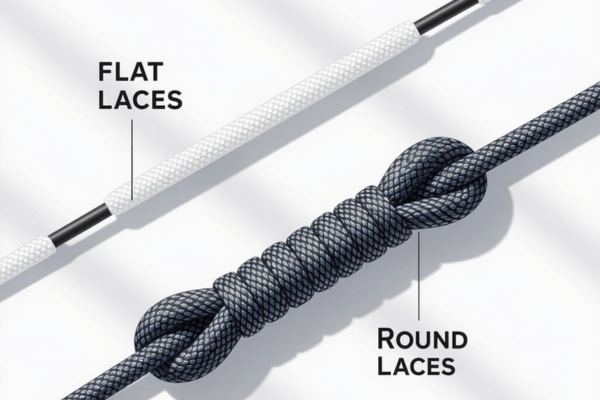
4: Flat vs Round Laces for Sneakers – What to Choose?
Sneakers are all about comfort, movement, and style—so your laces should match that energy. Here’s a shoelace comparison guide for flat vs round laces in sneakers:
Sports Shoes vs Casual Sneakers
- For running shoes, flat laces are preferred because they stay tied better during motion and distribute pressure evenly across the top of the foot.
- In casual sneakers, both types work, but round laces add a touch of style, while flat ones offer a classic look.
Breathability, Snug Fit, and Movement
Flat laces provide a snug and uniform fit, which supports foot movement and adds to overall comfort. They also lay flat against the shoe, allowing better airflow and reducing pressure points.
Round laces can be a bit bulkier and may come undone more easily unless double-knotted.
Brand Preferences and Trends
Most major sneaker brands like Nike, Adidas, and Puma use flat laces in their sports models for a reason—they perform better under action. However, designer sneakers or retro styles may use round laces for their visual appeal.
Flat vs Round Shoelaces Summary Tip:
If you’re going for performance and reliability, flat laces win. If style is your priority and you don’t mind retying now and then, round laces are a great pick.
5: Are Flat Laces Better for Sports Shoes?
When it comes to sports shoes, flat laces are often the preferred choice. They offer a snug, even fit across the top of the foot, which helps improve stability and comfort during physical activity.
One major reason athletes choose flat laces for sports shoes is their ability to stay tied. Unlike round laces, flat laces are less likely to come undone while running or jumping — making them a safer and more reliable option during workouts, games, and training sessions.
You’ll often find flat laces on basketball shoes, running shoes, and cross-training sneakers. This is because the impact of lace type on shoe fit can greatly affect performance. A secure fit means less foot movement inside the shoe, reducing the risk of blisters and improving energy transfer with every step.
Many professional athletes and trainers recommend flat laces due to their better grip, clean look, and durable knot hold. These small but important footwear accessories and their impact can change how your shoes perform under pressure.
In short, if you’re into sports and need a reliable, no-fuss option, flat laces for sports shoes are a smart choice.
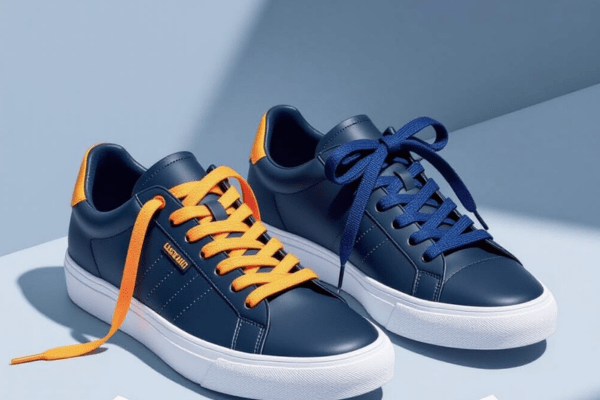
6: Round Laces for Hiking Boots – A Smart Pick?
When it comes to hiking boots, round laces are often the top choice—and for good reason. These laces are designed to offer a stronger grip, especially during heavy-duty outdoor use. Whether you’re trekking on rocky trails or walking uphill for hours, round laces tend to stay tighter and more secure throughout the day.
Unlike flat laces, round laces for hiking boots are built with stronger fibers and often have a rugged, textured surface. This helps them grip better when tied and makes them ideal for boots with lace hooks. The grip reduces the chance of your boots coming loose mid-hike—a common concern with flatter lace types.
Another important factor is the shoelace shape difference. Round laces are generally more cylindrical, which means they slide easily through metal hooks but still lock firmly when tightened. This provides better lace-up comfort, especially when you need ankle support in uneven terrain. For long hikes, lace-up comfort tips include double knotting your round laces and adjusting tension at each hook level for a customized fit.
In comparison, flat laces may look cleaner and feel softer, but they tend to loosen faster in rugged conditions. For serious hikers or outdoor workers, flat laces might not hold up as well in demanding environments.
In short:
Round laces for hiking boots are a smart pick if you need durability, grip, and long-lasting support—making your adventures safer and more comfortable.
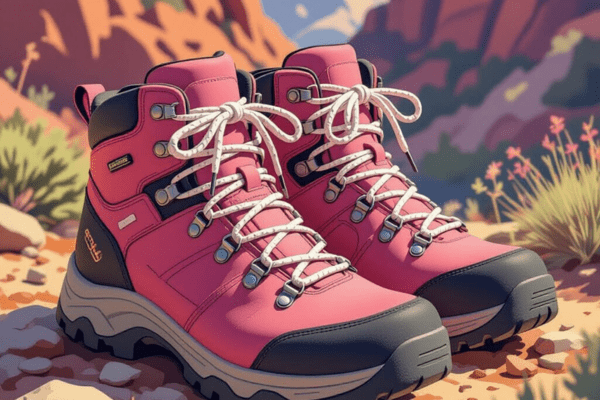
7: Which Shoelaces Last Longer?
When it comes to buying the right pair, many people ask: which shoelaces last longer? The answer depends on several factors like material, usage, and exposure to different conditions. Let’s break it down.
1. Durability Test: Wear, Tension & Weather
Shoelaces go through a lot — daily pulling, knotting, walking friction, and even exposure to water or sunlight. Over time, this causes:
- Fraying at the ends
- Stretching or loosening knots
- Breaking under tension
Durable laces are those that can handle this stress without falling apart too soon.
2. Material Matters Most
The material of your laces plays a big role in how long they last:
- Cotton Laces
Comfortable but wear out faster, especially with heavy use. Better for dress shoes where looks matter more than toughness. - Polyester Laces
Stronger than cotton, with better resistance to fraying. Ideal for sneakers and everyday casual shoes. - Kevlar Laces
Extremely durable and used in work boots or hiking shoes. They resist heat, tension, and rough environments.
If you’re looking for shoelaces for different shoe types — like sneakers, boots, or dress shoes — always match the material to your usage. Lightweight cotton for style, polyester for daily wear, and kevlar for high stress or outdoor use.
3. Knot Fatigue Over Time
Another factor in lace longevity is knot fatigue — the more you tighten and untie a lace, the weaker it becomes at the knot points. Flat laces usually hold knots better, while round laces (especially thin ones) may untie or wear out quicker unless made of strong materials.
Bottom Line:
So, which shoelaces last longer? For daily durability, polyester is a solid choice. For rugged use, kevlar wins hands down. And for stylish wear with less tension, cotton laces work best — just don’t expect them to last forever.
Want the best match? Always choose shoelaces based on your shoe type and how often you use them.
8: Best Shoelaces for Daily Wear – Flat or Round?
When it comes to shoelaces for daily wear, comfort and convenience matter most. Whether you’re heading to work, running errands, or just walking around town, the right laces can make your shoes feel better all day long.
Flat Laces – Great for Casual Comfort
Flat shoelaces are a popular choice for casual shoes, trainers, and loafers.
- They stay tied better, reducing the need for retying during the day.
- Flat laces offer a wider surface area, which helps distribute pressure evenly—making them more comfortable for daily use.
- They’re simple to wipe down and don’t hold on to dirt easily.
Round Laces – Sleek but Sometimes Slippery
Round laces look cleaner and more polished, especially with dress shoes.
- However, they can come undone more easily if not double-knotted.
- Some round laces, especially waxed ones, are durable but might feel stiff in casual footwear.
Maintenance Matters
Flat laces are easier to wash and dry quickly. For people who walk a lot or wear their shoes in dusty areas, this makes flat laces a better option for low-maintenance, daily wear.
Verdict:
For most people, flat shoelaces for daily wear are the better choice. They’re easy to tie, comfortable for all-day use, and ideal for casual shoes. Round laces may suit dressier occasions, but they’re not always the best for everyday comfort.
9: Final Verdict – What Should You Choose?
When it comes to flat vs round shoelaces, the right choice depends on your specific needs. Let’s break it down to make your choice easier.
•Use-Case:
- For daily wear or sports, flat laces are ideal. They remain firmly in place and provide a tight, comfortable grip on your feet.
- For hiking or outdoor use, round laces are better. They’re stronger and more durable under pressure.
Shoe Type:
- Sneakers and athletic shoes usually work best with flat laces. They’re more comfortable and less bulky.
- Boots or hiking shoes often pair better with round laces, which hold up well under strain.
Style vs Function:
- Flat shoelaces offer a cleaner, sporty look — great for casual and modern style.
- Round shoelaces are more traditional and focus on performance and strength.
Final Tip: If you want comfort and easy tying, go with flat shoelaces. If durability and support matter more, round shoelaces are your best bet.
No matter which you pick, make sure they match your footwear and daily use. The debate of flat vs round shoelaces comes down to personal preference and purpose.
10: Conclusion
In the end, choosing between flat vs round shoelaces depends on how you use your shoes. If you want a clean look, a tighter fit, and better comfort for sports or daily wear, flat laces are the better option. But if you need something stronger and longer-lasting for outdoor use or hiking, go for round laces. Each type has its own benefits, so pick the one that matches your style, shoe type, and daily needs.
Discover which is better for you: flat vs round shoelaces – comfort, style, or durability? Visit BestShoeLaces.com for the ultimate guide and top lace picks!
11: FAQs
1. Which is better: flat or round shoelaces?
Flat laces are better for comfort and a secure fit, especially in sneakers and sports shoes. Round laces are stronger and last longer, making them ideal for hiking or heavy-duty boots.
2. Do flat shoelaces stay tied better than round ones?
Yes, flat shoelaces usually hold knots more securely because of their shape and surface grip, making them less likely to come undone during movement.
3. Are round laces good for everyday shoes?
Round laces can be used for daily wear, but they’re often preferred in boots or outdoor shoes due to their strength. Flat laces are typically preferred for lightweight and casual footwear due to their simple and secure fit.
4. Which shoelaces last longer – flat or round?
Round laces generally last longer because they are made from denser materials and designed to handle more tension and wear.
5. Can I use flat laces in hiking boots?
While you can, it’s not recommended. Round laces are stronger and better suited for hiking boots since they handle rough use and keep your boots tightly secured.

